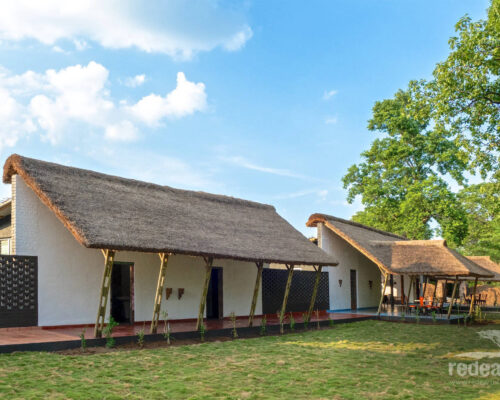
When Stella Kramrisch, an Austrian art historian dedicated her life in decoding and understanding the symbolism of Indian temples in the early 19th century, this gave way for more intensive research and understanding of why temples of India are more than merely sturdy structures to safekeep deities but a carefully constructed and intricately detailed draftsmanship that is significant to the human existence and beyond it.
One such temple marvel that you can visit near our resort in Gokarna is the Mahabaleshwara Temple
Around 12 kms away from Red earth resort in Gokarna, you will be enthralled by the peaceful aura of this holy place of worship.
The distinct Dravidian style and architecture of this temple made from granite with the lofty vimana and high gopura cannot be missed out.
Built in the 4th century, this Shiva temple is considered as the Dakshin Kasi with the spiritual powers equivalent to Kasi and Varanasi on the banks of River Ganga.
According to Hindu belief, This temple is denoted as one of the seven places of salvations in Karnataka (Muktishetras or Muktistala).
While taking less than an hour long ride from the resort in Gokarna to Sri Mahabaleshwara Temple located in the shores of the Arabian sea, you are welcomed by a serene calmness and breezy blow of wind.
King Mayurasharma of Kadamba dynasty, a scholar, devotee of Lord Shiva first started the construction of this temple around 345CE to 365 CE. Mayurasharma is said to have gone to Kanchi, the central place of learning and the capital of Pallava to only be insulted by one of the Pallava guards.
This antagonised King Mayurasharma and he vowed to avenge the Pallava King.
After the defeat, Mayurasharma gathered Brahmin families together from various lineages and began the administration of the temple.
The Mahabaleshwara Temple encapsulates the essence of Atmalinga (also referred to as the soul of Lord Shiva) through the form of a deity.

Legend has it that even before King Mayurasharma constructed this temple, Ravana, the antagonist of Ramayana, who was the demon king of Lanka and an adherent devotee of Lord Shiva wished to possess immorality by obtaining atma linga a.k.a the soul of Shiva.
Ravana desired Atmalinga to present it to his mother for her worship. Ravana’s mother was a staunch devotee of Shiva and when she was dutifully praying to a Shiva linga for her son’s well being, Indra, the god of Heaven, out of spite and envy, threw the Shivalinga in the sea.
Angered by this, Ravana underwent rigorous penance and abstinence to please Lord Shiva. He sang praises and made sacrifices to seek the boon of Atmalinga from Lord Shiva.
Lord Shiva presented himself to Ravana and gifted him Atmalinga with a condition that he must not put it down to the ground. Agreeing to the same, Ravan heads back to his journey to his mother.
Fearing that the Atmalinga would give Ravana immense powers that would lead to destruction, Lord Vishnu creates the illusion of dusk as Ravana makes his journey near Gokarna.
As Ravana gets ready for his evening prayers, he is faced with a predicament and unable to fulfill his prayers or keep the Atmalinga on the ground. While he ponders for a solution, a Brahim boy passes his way. Ravana hastily calls out to him and instructs him to hold the Atmalinga and to not put it on the ground while he finishes his rituals.
Lord Ganesha who is disguised as the Brahmin boy reassures Ravana that he will call out his name thrice and if he doesn’t return, he will place the Atmalinga to the ground and be on his way.
Agreeing to this, Ravana engages in his prayers and hastily Ganesha calls out Ravana’s name thrice. Not getting any response, he places the Atmalinga to the ground and vanishes among his cows.
When Ravana realised what had happened, he quickly chased after a cow left behind and only managed to get a hold of the cow’s ears while the rest of the cow’s body vanished below the Earth’s surface.
Thus the etymology of the town Gokarna comes from this legendary tale where Gow means Cow and Karna means Ear in Sanskrit.
Hopelessly, Ravan tried to lift the Atmalinga off the ground, unable to move it, a temple was built around with the name of “Mahabaleshwar” given to it symbolising the all powerful Atmalinga it holds.
Eons later, worshipers come from far and wide to get a glimpse of the power of this Atmalinga.
When you are staying in our resort in Gokarna, the spiritual magnetism of the Mahabaleshwara temple will compel you to make a visit.




